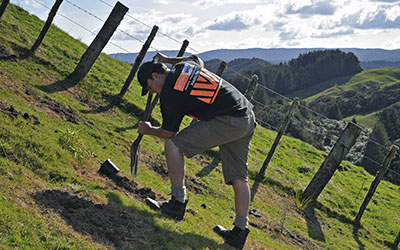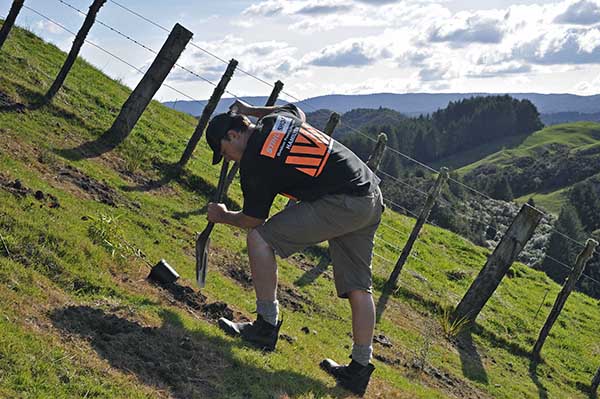Handbook helps spark indigenous plant revolution


Catching on at Taupō: Building on the success of the Mahurangi open-ground trials, a second major set of trials were established in the Lake Taupō catchment. But while reducing sediment generation is the principal objective in the Mahurangi Harbour catchment, nitrogen enrichment is the chief threat to the iconic Taupō. Here Michael Bergin powers into the planting, with the same energy that, last week, he took 16 000 measurements in four days. image Dr David Bergin
Twenty thousand down, and about as many again to go.
This week field technician Michael Bergin remeasured two indigenous plants trial blocks in the Weiti catchment and started in on the trials in Sandspit Road.
The trials are a world first in Aotearoa. They compare growth rates of plants raised forestry-style in open-ground nursery beds, with those raised in the more usual—usual for indigenous plants—containers. The aim is to drive down the currently very high cost of indigenous plants to somewhere closer to that paid for high-quality exotic forestry seedlings: 30 cents.
Designed by Michael’s father, Dr David Bergin, the trials were established in 2008. Michael and his siblings were involved in the setting out, and a year later he measured all 6240 plants established, with the editor hard-pressed to keep up, as recorder. It is testament to his eye-watering efficiency that on Friday, when he had the services of a gang of highly motivated Rodney College students as part of the inspirational Gateway programme run there, it took a similar time for four to measure 720 plants to that which it would have taken Michael, and his stumbling scribe.
The data collected in 2009 broadly showed that the survival and canopy spread of the PB3-sized container raised plants, and the open-ground plants, were similar. This was an entirely encouraging result given that the nominal $1.50 charged for the open-ground plants was a dollar less than for the PB3-sized plants. Since that time however, Taupō Native Plant Nursery has halved the price to $0.75, for open-ground plants ordered in quantity. Meantime, the Hillson-sized root trainer plants performed so poorly in the trials that even at $1.10 each they proved much less cost effective. This reflects the much smaller size of root trainer plants when they leave the nursery, making them susceptible to being smothered by competing vegetation, and to ‘predation’ by pūkeko—te kōuka (cabbage tree) in particular are targeted and uprooted, conceivably through an instinctual imperative of pūkeko to maintain a range free of predator-concealing vegetation.

Spring From the Land: With his ‘If we don’t protect the land, we have no foundation for future success.’, Theo Spierings honours Fonterra’s Latin-derived name and salvages the co-op’s commitment to implementing the Dairying and Clean Streams Accord, which helped spark the open-ground revival. image Fonterra
Theo Spierings’ refreshingly unequivocal commitment to implementing the long-languished Dairying and Clean Streams Accord should serve as an object lesson to chief executives, and cynics generally, everywhere. Rather than choose to see to cost of compliance as an excuse to prevaricate ’til the proverbial cows come home, Fonterra has grasped the opportunity to re-write what had become an tedious and dispiriting narrative, much as it has done by reintroducing free milk to 20 000 primary school students in Northland. The National Party ended the previous scheme, a world first by Labour 30 years earlier, in 1967. Margaret ‘Thatcher, Thatcher Milk Snatcher’ followed suit in 1971, but later said she had learned a valuable lesson from the experience:
I had incurred the maximum of political odium for the minimum of political benefit.
Any odium attracted by Keith Holyoake’s government was mitigated by the disrepute the programme had earned through the appalling lack of care taken with the handling and storage of the free milk, whereby generations gagged on their half-curdled half pints.
Fonterra’s unfolding redemption deserves unreserved commendation, and there is a Mahurangi connection. The clean streams accord, or more specifically the 2004 handbook Clean Streams: A Guide to Managing Waterways on Auckland Farms, which provided a trigger point for the open-ground indigenous plants project, was co-funded by the cooperative. The handbook included a worksheet to aid calculation of the likely costs of a riparian fencing and planting project. In addition to prices for indigenous restoration species, indicative costs of planting exotic and indigenous forestry trees were provided. It was the stark contrast between the costs of the exotic and indigenous forestry plants—$0.30 and $4.70 respectively—that sparked the quest to learn why the latter should be so comparatively expensive.

Another Revolution Slotted-In: Hastings scientist and inventor Dr John Baker’s Cross Slot seed drill has quietly begun a green revolution that will play a central role in the war to save a liveable planet. The challenge now is to ensure a population blowout doesn’t again blow the opportunity for the billions of the Earth’s inhabitants otherwise doomed by global warming. The other challenge is to adapt open-ground nursery practices to this ‘Nobel food prize’ –nominated no-tillage method. image Cross Slot
Scale was an obvious factor, but surprisingly not the main one. The principal difference arises from the vastly different nursery production methods used. Whereas indigenous plants are predominantly raised in containers, a process typically involving much manual labour, forestry seedlings are raised in large-scale open-ground beds utilising a high degree of mechanisation. The reason the job of raising indigenous species was left to domestic plant nurseries rather than have been undertaken by forestry nurseries was mostly due to yet another instance of neoclassical ideology trumping real world pragmatism—the dismantling of the world-leading New Zealand Forest Service, where methods perfected for raising exotics had been successfully adapted to raise indigenous species, many of which are comparatively delicate at the seedling stage. At the time, the state-owned forest service was gearing up for large-scale indigenous forestry.
Although it will be a few months before the balance of the open-ground trials are measured and the data is entered and analysed, the impression gained last week in the field is that, three years on, the pattern is much same: Plants raised open-ground or in the large containers are comparable; those raised in the small containers—Hillson-sized root trainers—are smaller and their survival is comparatively poor.
Despite another budget and yet another assurance that the budget deficit will be down to zero by 2014–2015, as economist Dr Brian Easton puts it:
With the exception of the Minister of Finance, nobody I know thinks the goal is achievable.
Pursuing its ‘bigoted budget’, the National-led government has at the same time strongly signalled to local government that it will receive reduced central government funding, and it is even prepared to push Christchurch into selling assets, rather than raise a levy to meet the one-off costs incurred by post-earthquakes rebuilding. Not to put too fine a point on it, funding for large-scale indigenous restoration and forestry is likely to be spread very thin by the likes of Auckland Council, for some time to come. This means that it is now imperative that any portion of funding used for the purchase of plants is put towards the most cost-effective option available—which the science can now say is open-ground, as opposed to container-raised.

Hundred Years War: Nearly a quarter of a century ago, economist Mark Harrison warned ‘…the war against CO2 emission will be a Hundred Years’ War—at least’. image University of Warwick
If National is in a position to lead another government following the 2014 election, Aotearoa faces a further five and a half years where little will be done to mobilise the country, much less its 30% Māori and Pacific Island young unemployed, to begin the now desperately overdue action on climate. An army of workers should already be deployed establishing sand-binding plants, on most beaches. Elsewhere millions more pōhutukawa are urgently needed. Ultimately none of this will save but a few sandy beaches, but it could make the difference as to how many generations get to enjoy a coastline resembling that alongside which civilisation evolved. Once multi-metre sea-level rise kicks in, possibly as early as by the end of this century, sandy beaches will largely be a geological artefact—much of the coastline will be an eroding and muddy mess until long after the sea level stabilises. And aside from aesthetic considerations, a muddy coastline is conducive to neither good fishing nor shellfish gathering.
Some who despair of Labour doing more than matching National’s fiscal parsimony suggest the left should switch its support to the Green Party, whose finance spokesman Dr Russel Norman is sounding increasingly sane across the political spectrum. But the new motivated Aotearoa, the ‘God’s own country’ that David Cunliffe suggests can be reclaimed, will need buy-in from more than just a bare majority of New Zealanders. Even if David Shearer suddenly begins to sound like a leader, and the Labour and Green parties form the core of the next government, about 40% of votes cast will be for National—a recipe for a lurch back to neoliberalism at the first electoral opportunity.
The long-despised two-party system has, post the adoption of proportional representation, been replaced by a two-coalition system—one led by National, the other by Labour. What the political parties have failed to recognise is that the electorate could care less about them; it just wants elected representatives to diligently and democratically devise the best policies possible for the country. In times of war, parties readily put country first and form grand coalitions, and global warming was always going to be a hundred years war—at least. What is still far from certain is whether humanity will fight it shoulder to shoulder, or tribe against tribe.
Only one way is even theoretically winnable.
See also Open-Ground Indigenous Plants Report
